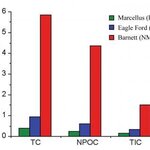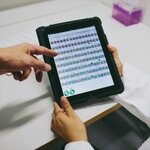Technology

Raloxifene is a U.S. Food and Drug Administration (FDA)-approved treatment for decreasing fracture risk in osteoporosis and it is effective at reducing fracture risk, but only partially by suppressing bone loss.
With the use of wide- and small-angle x-ray scattering (WAXS and SAXS, respectively), researchers carried out experiments at the U.S. Department of Energy's (DOE's) Advanced Photon Source (APS) at Argonne National Laboratory that revealed an additional mechanism underlying raloxifene action, providing an explanation for how this drug can achieve equivalent clinical benefit.
These…

A middle aged, male, investment banker arrives at the emergency department with complaints of nausea, vomiting, anxiety and tremor. At business lunches and then at home every evening, he was drinking too much so, worried about his health, he decided to quit drinking and had his last Scotch 24 hours before coming to the emergency room.
It's a common scenario in emergency rooms - a patient suddenly stops regular, excessive alcohol consumption and develops withdrawal symptoms.
The most commonly used clinical sign of withdrawal is tremors, especially in the hands and arms. Judging tremor severity…

Rice University scientists have produced a detailed analysis of water produced by hydraulic fracturing of three gas reservoirs and suggest environmentally friendly remedies - advanced recycling rather than disposal of "produced" water pumped back out of wells - could calm fears of accidental spillage and save millions of gallons of fresh water a year.
The amount of water used by Texas drillers for fracking is tiny, and much of it is recycled, but even at only 1.5 percent of that used by farming and municipalities, it still amounts to as much as 5.6 million gallons a year for the Texas portion…

Researchers at Rice University have synthesized a recently discovered natural fungus-derived antibiotic, viridicatumtoxin B, which may shelp bolster the fight against bacteria that evolve resistance to treatments in hospitals and clinics around the world.
The work reported this month in the Journal of the American Chemical Society (JACS) focused on a tetracycline discovered in 2008 by scientists who isolated small amounts from penicillium fungi. The yield wasn't nearly enough for extensive testing, but it provided a basis for the discoverers to analyze its structure through…
A growing number of consumers are willing to pay a premium for fruits, vegetables and other foods labeled "organic", but whether they're getting what the label claims is another matter.
For over a decade it has been known that since there is no surprise spot testing of farms, and very little on imported food at all, organic labels may be meaningless. A few years ago, 25 percent of the organic food bought from Whole Foods stores was found to be conventional.
Like "Kosher" or "Extra Virgin" olive oil, the label is really only meaningful if you choose to believe it, but scientists are…
Current x-ray examinations capture only 20 percent of cases but there is a better way, according to Norwegian researchers. With modern ultra low-dose CT, that number climbs to 90 percent.
In lung cancer, the prognosis is poor. In Norway, 85 percent of lung cancer patients die within five years, the authors say, and what is unfortunate is that the tumor can grow for a long time before even being detected. Most patients have their first diagnosis made by x-ray imaging.
Yet no one had investigated how well x-ray images function when it comes to detecting lung cancer and other diseases of the…

In a closed-loop control approach to managing type 1 diabetes, glucose sensors placed under the skin continuously monitor blood sugar levels, triggering the release of insulin from an implantable insulin pump as needed.
The aim of this closed-loop insulin delivery system is improved control of blood glucose levels throughout the day and night. But a new study in adults and adolescents found that mean blood glucose levels remained at safe levels 53-82% of the time, according to the results published in Diabetes Technology&Therapeutics.
Howard Zisser, MD and an international team of…

Laboratory-grown replacement organs are the future; since they will be grown from a patient's own cells, there will be no need for immuno-suppressive drugs, and it will eliminate the need for organ donors and waiting lists.
Toward that goal, scientists have grown a fully functional organ from transplanted laboratory-created cells in a living animal for the first time; a thymus, the organ next to the heart that produces immune cells known as T cells that are vital for guarding against disease.
The team from the MRC Centre for Regenerative Medicine at the University of Edinburgh took…

A method based on computer vision algorithms similar to those used in facial recognition systems combined with visualization of only the diagnostically most relevant areas can mean a big breakthrough in malaria diagnostics, according to a new paper. Tablet computers can be utilized in viewing the images.
In this new method, a thin layer of blood smeared on a microscope slide is first digitized. The algorithm analyzes more than 50,000 red blood cells per sample and ranks them according to the probability of infection. Then the program creates a panel containing images of more than a hundred…

Science 2.0 fave Ora TV has a fun show-you-should be-watching-if-you-are-not-already-watching called Dweebcast, where host Andy Riesmeyer covers all things nerd.
They have begun a new segment called The Science Of Sci-Fi, and they asked Science 2.0 to help pick the perfect person to talk about...human cloning: Joanne Manaster, Lecturer in Biology at the University of Illinois and all-around science advocate jumped into the fray.
Andy quickly dispenses with ethical quandaries and gets right to the heart of the issue for most in the science and geek society: how do we make all those girls in…